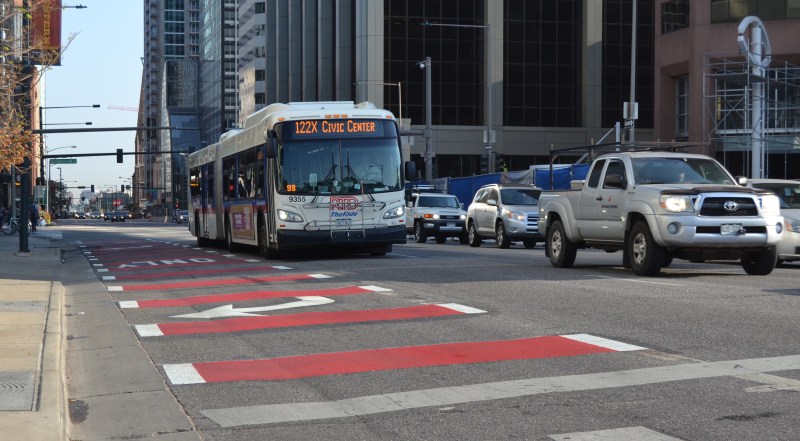Eyes on the Street: 24/7 Bus Lanes Pop Up on Broadway and Lincoln
All-day bus lanes and new pavement treatments will improve bus service. But the project is a small step, not a bold leap.

As of Sunday, people who ride the bus on Broadway and Lincoln no longer have to travel during rush hour to benefit from the bus lanes, because they’re now operational 24 hours a day, seven days a week.
Denver Public Works crews also began painting the bus lanes red on parts of Broadway, hoping to deter drivers from illegally entering the transitway, which should improve bus reliability and reduce delays. DPW won’t use any red paint on Lincoln.
Crews won’t paint the bus lanes solid red like in San Francisco, though the simple color cue has worked wonders there. Instead DPW and RTD are hoping blocky, red rectangles will do the trick — though not on entire spans of street. The red paint will only appear near intersections between 17th and Colfax, between 8th and 9th avenues, and “a few areas parallel to the bikeway between Bayaud and Virginia,” DPW spokesperson Heather Burke wrote in an email.
Overhead signs with flashing lights indicating the bus lane will now stay lit 24/7, while signage and “BUS ONLY” pavement markings will appear periodically along the lanes.
Cars can still enter the bus lanes, however, to turn right onto adjacent streets, into driveways, and to parallel park.
The new bus lanes are an incremental step, project manager Kristina Evanoff said, in what will eventually be a more transit-rich corridor. “It’s about the reliability of transit, but also to prepare us for the future,” she said.
On Broadway the 24/7 bus lane stretches three miles, from 17th Avenue to Exposition Avenue — not quite to the I-25 and Broadway RTD station. The improved lane on Lincoln only stretches about a mile, from 6th Avenue to 14th Avenue. RTD also cut some redundant bus stops that slowed service.
The project is technically a year-long a study — part of the same redesign that includes the Broadway bike lane. DPW will measure how the changes affect on-time performance, ridership, and whether drivers comply with the rules more often, Evanoff said.
These changes will no doubt improve transit on Broadway and Lincoln — and it’s good to see the city using its control of the right of way to improve RTD service.
But more could be done: Solid red lanes on the both streets, for example, or the elimination of some right turns to keep cars out of the lane. The National Association of City Transportation Officials, which has been helping the city with this project, encourages the latter.
This project is a positive step toward transforming Broadway and Lincoln from car sewers into streets for everyone. But, like the first iteration of the Broadway bike lane, it’s a small step — not a leap forward.
This article was updated to include Evanoff’s comments.


